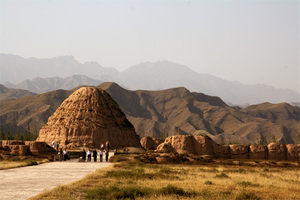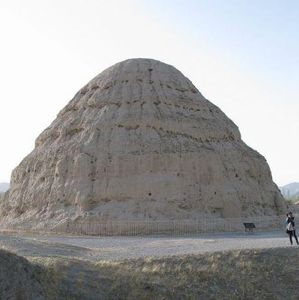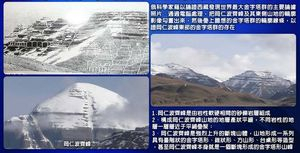PureInsight | November 8, 2023
[PureInsight.org]
Ningxia Yinchuan: Western Xia Imperial Tombs' Eastern Pyramid
Located at the foot of the Helan Mountains in the western suburbs of Yinchuan, Ningxia province, the Western Xia Imperial Tombs is one of the largest and best-preserved imperial tomb complexes in China. It is known as the "Eastern Pyramid" and is comparable to the Ming Tombs in Beijing and the Song Tombs in Gongxian, Henan.

Within an area of 53 square kilometers, there are nine imperial tombs and 253 accompanying tombs scattered throughout the tomb complex. Each of the nine royal tombs is an independent and complete architectural complex, with a solemn and majestic appearance, oriented from north to south and elongated in shape.
The nine existing imperial tombs in the Western Xia Imperial Tombs are Yu Ling, Jia Ling, Tai Ling, An Ling, Xian Ling, Xian Ling, Shou Ling, Zhuang Ling, and Kang Ling, arranged in accordance with the ancient patrilineal system of ancestral temples. The left side is "Zhao" and the right side is "Mu", with fathers buried in the "Zhao" side and sons in the "Mu" side. They were arranged in two rows from east to west. There are 253 accompanying tombs.
At the northern end, there is a three-courtyard building site, which is believed to be either a tomb or an ancestral temple. On the eastern edge, there are brick and tile kilns and lime kiln remains, which are part of the tomb complex's kiln workshop.
The Western Xia Imperial Tombs drew upon the strengths of Tang and Song imperial tombs and were also influenced by Buddhist architecture, creating a unique form of Chinese tomb architecture with magnificent scale and orderly layout. Each imperial tomb is composed of several parts, including the gate tower, divine wall, stele pavilion, corner tower, moon city, inner city, offering hall, and spirit platform.
Each imperial tomb complex in the Western Xia Imperial Tombs is a complete architectural complex covering an area of over 100,000 square meters, oriented from north to south and built on flat ground.

The third tomb complex is the largest and best-preserved of the nine Western Xia imperial tombs, covering an area of 150,000 square meters. Archaeological experts have identified it as the "Tailing" of Li Yuanhao, the founding emperor of the Western Xia dynasty.
The Eastern Pyramid Is Not an Octagonal Tower Base and Is Not Found in Central Plains Tombs
Before the excavation of the third tomb complex, experts believed that the "Eastern Pyramid" structure was a solid rammed earth platform with an octagonal cone shape and seven layers that gradually slope inward. Later, it was discovered that the tomb tower was not octagonal, but had a circular base with a diameter of about 34 meters. The number of layers on top of the base is either seven or five, but it will require further measurements to determine.
The base of the structure is slightly elevated, with each level gradually decreasing in size, forming a tower-like burial platform made of rammed earth, solid bricks, and wooden beams with a densely eaved structure. No stairs or steps leading to the top were found, and only a large amount of brick, tile, and animal ornament remains were discovered near the corners, indicating that the structure above the corners was a solid tower-like building made of bricks, tiles, and animal ornament remains arranged in a high and low staggered pattern, which cannot be climbed up by steps or terraces.
The entire central axis of the burial site displays a unique characteristic of Western Xia tombs: the burial passage faces directly towards the offering hall and is connected to it, which was discovered for the first time. This is likely related to the Western Xia people's beliefs and worship of ghosts and gods.
Archaeologists Discover Mysterious "Bird Man" in the History of the Western Xia
On April 30, 2000, during the excavation and cleaning of the No. 3 tomb in the Western Xia Imperial Tombs, a team member discovered a complete statue of a bird-headed human in the northeast corner of the tomb. According to archaeological experts, this is the "Kalavinka" described in the "Amitabha Sutra", which is a bird species in the Himalayas that can produce wonderful sounds. In Buddhism, it is known as the bird of the Pure Land and is often used as a decoration in Buddhist architecture. This was the first discovery of its kind in Western Xia archaeology.
The Western Xia royal tombs have become an important cultural heritage site for people to understand the history and explore the culture of the Western Xia dynasty. These tombs, made of rammed earth, have undergone thousands of years of changes and destruction caused by both natural erosion and human activities. The resulting cavities and gullies, some of which are up to two meters deep, pose a serious threat to the safety of the tombs. The tomb sites have entered a period of large-scale collapse and are in danger.
Tibet: The World's Largest Pyramid Complex
Mount Kailash is the main peak of the Gangdise Mountains, located in the Pulan County of Tibet Autonomous Region. Although it is not the highest peak in Tibet, it is quite famous. The Gangdise Mountains are considered the "sacred mountains" in the hearts of the Tibetan people, and the nearby Lake Manasarovar is called the "holy lake". Is there really a magical pyramid complex here?

The shape of Mount Gang Rinpoche does indeed resemble that of a pyramid. The preliminary conclusion is that this pyramid-shaped mountain is a natural formation. Even if this mountain is not a pyramid, could it be the natural prototype that the pyramids imitate?
The Tibetan monk Losang Rampa clearly recorded this in his book, stating that it is a relic of the civilization of Atlantis. The book The Sirius Mystery also describes this, making people believe that we are currently in a revelation stage, a watershed moment in the history of human civilization.
In August to October of 1999, a group of Russian scientists went on an expedition to explore the legendary "City of the Gods" in western Tibet and discovered the world's largest pyramid complex. The leader of the expedition, Murodakhshyev, claimed that they were convinced that there is the world's largest pyramid complex in Tibet, and a strict mathematical law connects the Tibetan tower complex with the Egyptian pyramids, Mexican pyramids, and the prehistoric stone statues of Easter Island and Stonehenge.
According to reports, the Russian scientists claimed that they had discovered more than 100 pyramids and various ancient relics, which are scattered around Mount Kangrinboqe at an altitude of 6,714 meters. The pyramids are of various shapes and sizes, and their sheer scale is breathtaking.
In May and June 2006, the Russian newspaper "Arguments and Facts" published five articles stating that in August to October 1999, Russian scientists discovered more than 100 pyramids in Tibet during their exploration. The report stated that by carefully observing the contours of the Tibetan pyramids, it is clear that they are stone structures with concave and flat surfaces. In addition, the Russian scientists also discovered huge stone sculptures of human figures. Therefore, it can be asserted that there exists an ancient architectural complex in Tibet primarily composed of pyramids.
However, some people have questioned whether the scientists mistook mountains for pyramids. Mordvintsev said that this was their concern, so they studied all the photos, pictures, and videotapes. They used the method of outlining the mountain contours and inputting the images of pyramids and mountains into the computer to outline the main contours, so they could distinguish between mountains and pyramids.
Mordvintsev pointed out that when people think of pyramids, they tend to think of the shape of the Egyptian pyramids. However, pyramids come in different shapes. The Mexican pyramids and the lesser-known Egyptian Lepsius pyramid are both step-like. The mountain range around Mount Kailash and its surroundings, which have a horizontal step-like shape, are called "step pyramids," while the natural peaks around them do not have this structure. There is also an artificial ladder on the southwest side of Mount Kailash that leads to the top of the pyramid, and the flat-topped mountains in the area are all pyramids with triangular sides.
What is the purpose of the 'Tibetan pyramids'? Why do they have different shapes? Mordova Shev offers an opinion, suggesting that the purpose of the pyramids is currently unknown, but they may have a unique connection to time tunnels. There are various energies inside the pyramids, and to preserve and control them, our ancestors built a variety of pyramid shells and assembled them on the pyramids. What is the basis for this incredible theory? Mordova Shev did not elaborate on it.
Mordova Shev believes that the Atlanteans, who controlled the prehistoric civilization one million years ago, built these pyramids. The Atlanteans were 3 to 5 meters tall, with membranes between their fingers like webs...
If this news is true, not only Tibetan history but also the history of Asia will be rewritten.
To be continued.
Chinese version: https://big5.zhengjian.org/node/75983
